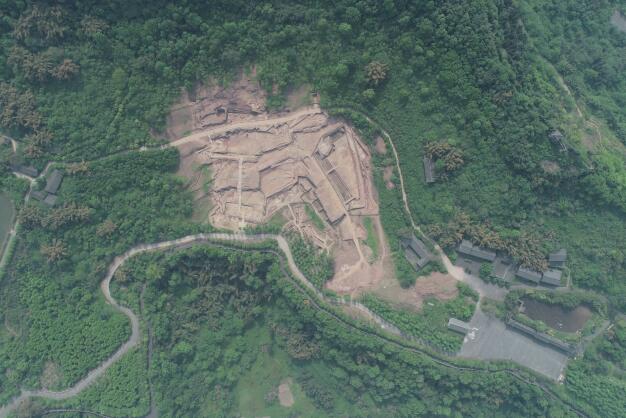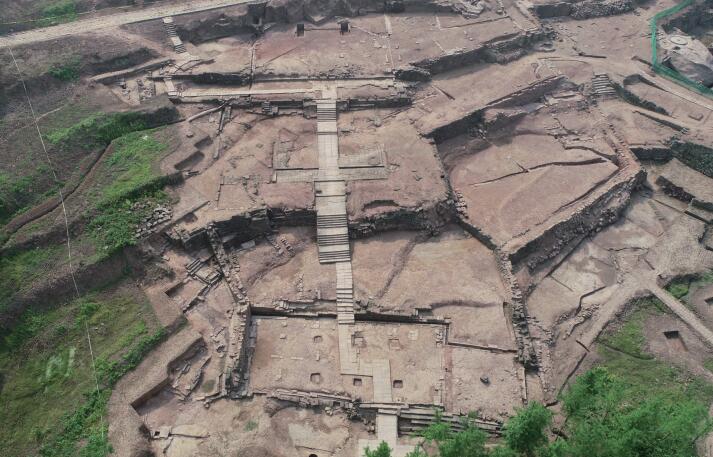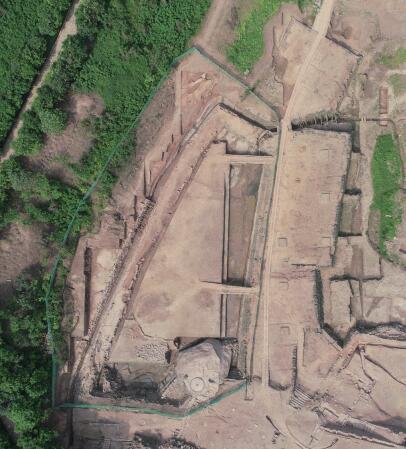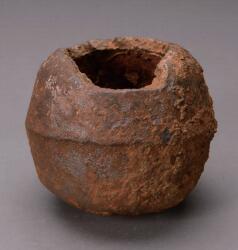The Administrative Office Yard of Southern Song Dynasty Found in Diaoyucheng, Chongqing
Diaoyucheng was located in the Diaoyu Mountain of East Peninsula in Hechuan District, Chongqing. From August, 2017 to April, 2018, Institute of Chongqing Municipal Cultural Heritage Research Institute conducted fourth initiative archaeological excavation. 59 features had been found, such as house foundations, ash pit, drainage, wall, road, and gate, etc. More than 644 samples like pottery, porcelain, bronze ware, iron ware, and stone tool were unearthed.

The Aerial Photo of Diaoyucheng Site
Yashu Building Remains
Yashu was the administrative office yard or residence of a local bureaucrat or mandarin in ancient China. The Yashu building was divided into two parts, which were office area and garden area. Office Area was consisted of three parts, enclosure wall, central axis building group and annex; Garden Area was centered by a large pond H1, surrounded by gates, pavilion, high platform building, flood intercepting trench and vaulting culvert, etc.

The Office Area
Office Area
The shape was close to character “凸” in plain, covered over 7000 square meters. The inner lined by the central axis was gate-middle court-hall-back hall, and small annexes were on the two sides of the central axis.
Wall was around Yashu Office, which was rammed earth covered stone outside, 308 meters in length, 1.4 to 3 meters in width with ruined height 0.5 to 3.2 meters. Under drainages were circled around the wall.
The central axis building group was the core of the Yashu Office, which was a group of four-hall on depth courtyards, from the front to back were front gate, middle court, office and back hall, which were connected with paved path or road. F18 was a gable and hip roof building with 5 rooms wide, 3 rooms deep and corridor. Middle Court F29 was presented as rectangle shape, including etiquette door, front office, wing room and patio etc.

The Rest Area
The office area’s annex was mainly located on the two sides of the central axis buildings, which was relatively small. The right side annex was excavated less, among which the Storage F47 was important. The left side was fully excavated, from low to high there was a three step platform building, F4, F6 and F17, which was connected with pave path in poor condition.
Garden Area was located in the left side of the office area, presented near a trapezoid, covering 4000 square meters. This area was centered with the large pond with a door room in the west, and north and east parts were large high platform buildings; the northeast end was a pavilion on a large natural rock; west and south part was the flood intercepting trench around the large pond and vaulting culvert.

Stone Engraving Beast
Large Pond H1 covered nearly 1400 square meters, and contained over 4000 cubic meter. Door Room F2 was located in the very front of the garden area, which was the front gate to coming in and going out with housing function. High Platform F1 and F16 were large buildings near water. Pavilion F54 was built on the large natural rock on the northeast corner, which could be a hexagonal or a round pavilion.
The above ground buildings at Fanjiayan site was ruined with no existence, while the drainage system was well preserved, which was scientifically planed, with open trench, under ditch, impounding reservoir, and grit basin, etc, which could help quickly draining the rain, preventing ponding.

Iron Landmine
Assemblage
The Site was rich in the unearthed relics, among which the relatively important ones were iron mine, bronze chess pieces, tiles with characters, blue and white porcelain, etc. H1 and H27 were unearthed a iron landmine in each of them, which was the first time to discover gunpowder weapon in Fanjiayan site, even in Diaoyucheng.

Bronze Chinese Chess
Academic Significance
Based on the present discovery, the Southern Song Dynasty’s Yashu building ruins at Fanjiayan was near 15000 square meters, which was the only well preserved Song Dynasty’s Yashu building with large scientific excavation, unearthed plenty features and relics, provided academic value, historical significance and precious materials for the study of Song Dynasty’s city and Yashu Building’s development, ancient architecture, ancient fire weapon and Song-Yuan Dynasties’ war. It was the core of Shancheng Site of the war between Song and Mongol in Diaoyucheng, which offered strong support for Diaoyucheng’s application for the list of world heritage. (Translator: Lang Langtian)

